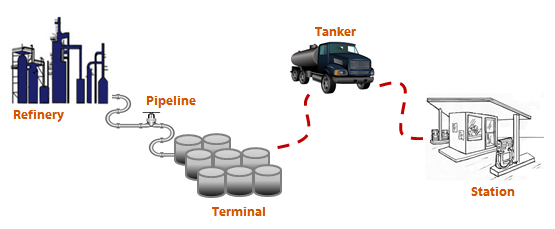RL Blogs

By Ralph Laurel
Sep 10, 2018Insights on how products flow from an oil refinery to the pump. |
|
Many oil refineries are constructed near major cities, but still require additional logistics to efficiently deliver refined products (i.e. gasoline and diesel) to local service stations. Some refineries can ship products directly to a gas station through their own on-site Terminal, but many refiners rely on product pipelines to ship finished product to off-site terminals.
Everyone surely has seen tanker trucks transport fuel to a gas station, but many do not realize that most of these tanker trucks fill up at terminals instead of the actual oil refinery. Terminals are not as hazardous to the community as refineries, so many terminals can be placed in close proximity to population centers.
Terminals are just a collection of storage tanks and truck offloading facilities, so they can enable convenient resupply of local gas stations. An oil refinery produces gasoline, jet, and diesel, and ships the products underground through product pipelines to these terminals. Small tanker trucks can then load products from terminals and distribute fuel to various service stations over several quick round trips.
Product pipelines are particularly interesting because one pipeline can carry many different types of products (gasoline vs diesel) and also many different grades of products (premium gasoline vs regular gasoline). An observant person may ask “well, how can you ship different types of products and not mix them all up”? The answer lies in the product shipping order sequence and the pumping rates.
Let’s take a typical refinery that ships 4 different products on one product pipeline:
Generally speaking, the most optimal way to ship these product out of the refinery in the following order.
Since the refinery consumed a great deal of energy to make each finished product, the goal is to minimize product downgrade during shipping. This is done by sequencing Like products next to one another.
As you can imagine, the greater the number of different batches that are shipped over the pipeline, the higher amount of interface material is downgraded. Efficient refiners schedule pipeline batches in as high volumes as possible to reduce the amount of interface material created.
Most refineries have several pipelines that can carry products to different areas. Depending on how many cities, states, or countries a refinery supplies, there can be multiple pipelines that carry product to various terminals. An intricate supply chain web can be created as some terminals connect to additional terminals, and so on.
One interesting note to mention is that while Jet fuel can go through a terminal similar to Gasoline and Diesel, Jet fuel continues down the path of pipelines to reach its end destination. Many major airports have receiving facilities on site, so jet is pumped directly from a terminal to the airport storage tanks.
The next time you fill up at a station, or see a tanker truck carry fuel around, you now understand that your gasoline or diesel product likely shipped through a terminal before reaching your service station. |
|











